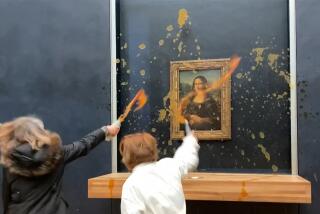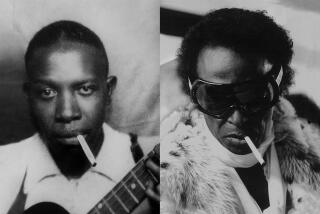Dollar Signs Knock Art World Senseless
- Share via
NEW YORK — Boggling multimillion-dollar prices for art at auction this month threaten the ability of museums to buy and exhibit great works for the education of ordinary citizens.
Worried curators and museum directors on both coasts responded with unanimous concern to telephone inquiries about the effect of two weeks of modern and contemporary sales that garnered hundreds of millions at Sotheby’s and Christie’s and broke dozens of records. The top mark for a modern work escalated when Picasso’s “Mother and Child” went for $24.8 million. A phenomenal new high for a contemporary work was set by Jasper Johns’ painting “False Start” at $17 million.
From the prestigious halls of Washington’s National Gallery to ambitious small repositories like California’s Newport Harbor Art Museum, the anxious scenario is the same. Newport director Kevin Consey outlined the problems saying that even generously endowed museums cannot afford to build their permanent collections in a market where several years of heated escalation has brought such astonishing prices as $53 million for a Van Gogh sunflower painting considered mediocre by connoisseurs.
Consey and his colleagues think patrons are less likely to donate art of astronomical worth especially since recent changes in tax laws allow far smaller deductions than previously.
Popular temporary exhibitions are threatened by increased insurance, shipping and security costs.
Richard Koshalek, director of Los Angeles Museum of Contemporary Art, describes the market as fueled by an international group of mega-rich buyers who compete fiercely for a small number of “anointed” artists such as Johns and Francis Bacon.
“The gap in price between a Johns and other fine artists like Mark Rothko and Franz Kline is still astonishing,” says Koshalek, who feels relieved that MOCA bought its core collection from the holdings of Count Panza for $11 million in 1984. The museum estimates its worth to have risen to about $34 million in just four years--a nice dividend but creating new worries about insurance.
“We’re going to have to concentrate on younger artists and hope that benefactors will donate works by more established people.”
Koshalek says he is picking up professional whisperings that the market is due to level off soon perhaps taking a precipitous fall.
Even Malibu’s immensely wealthy J. Paul Getty Museum is flummoxed by current prices. Director John Walsh admits that the Getty could compete directly in the market but says it is hesitant to do so because, “We think it is a classic ‘bubble.’ These buyers are getting some risky status symbols. The resale value on a $53-million Van Gogh is not a fixed thing like that of a Rolls-Royce.
“There is an ocean of money out there from corporate acquisitions and mergers. There is a willingness to make a relatively small investment in interesting and exciting property like art. Some of those investments are solid but there is a lunatic fringe out there.
“We will have to pay more too, but we have set limits. Within them we’ll continue to seek out the rarest and the finest. We just paid $1 million for a drawing by (Dutch old master) Pieter Saenredam. That is a great deal for a drawing but it is of far greater artistic worth than a fourth-rate Renoir going for five times as much. We will proceed privately and quietly, avoiding the bright lights of the big auctions.
“I suppose the good news is that all these works being sold have not reached their final destination. They are still circulating in private hands and could still conceivably come to museums.”
John Mandle, deputy director of the National Gallery, said Washington’s great gallery is particularly worried since it has gone heavily into contemporary art since opening its glossy East Building 10 years ago.
“We don’t even own a Johns and where are we to get a fine one now?”
He ascribes the current price boom in part to purchases made with foreign capital at a time when the dollar is weak.
“If a Japanese or Australian or Scandinavian collector buys a work with cheap dollars he can win two ways. If he decides to sell later he can profit both from an increase in the value of the work and the fact that he bought it with cheap dollars.
“American museums need to develop clever strategies to deal with the situation. For one thing they can encourage long-term loans where privately-held works are mixed with permanent collections.
“I’m actually more concerned about artists than museums. What do these high prices do to the artistic psyche? Are we going to create a generation of yuppie artists trying to make a killing with single flashy acts rather than working for sustained careers?”
Philadelphia museum curator Mark Rosenthal organized an exhibition of Johns’ recent work currently on view in Philadelphia. He shares his colleagues’ concerns and is puzzled by the irony of high prices being paid for Johns, an artist long regarded as hermetic and difficult.
“In the past Johns has said that prices have really nothing to do with the work. He doesn’t like talking about it and as far as I know he left town during the sales.”
Veteran administrator James Demetrion who currently directs Washington’s Hirschhorn Museum said: “I’ve never had so much money to spend on art and it doesn’t mean a thing. I’m told there a lot of amateur collectors out there who only own one thing. I am afraid a lot of these works will never come to museums but just go on being swapped around out there.
“I guess it means museums and universities have done their job in educating the public to appreciate art and now we are suffering from it.
“There is a speculative aspect to it but I truly believe there is now a broader and more sincere interest in art.”
Graham Beal, chief curator at the San Francisco Museum of Modern Art, says present links between prestige and art remind him of 17th-Century Rome with its emphasis on opulent collecting for self-aggrandizement.
“I am enough of a traditionalist to lament the possibility of a wave of fragmentation that could result in a proliferation of private museums. The thing that knocks us out about great museums like the Louvre or the Metropolitan is the coherence of their collections. One little private museum like the Frick is a jewel, but compare it to the Met and which would you rather have?”
More to Read
The biggest entertainment stories
Get our big stories about Hollywood, film, television, music, arts, culture and more right in your inbox as soon as they publish.
You may occasionally receive promotional content from the Los Angeles Times.










